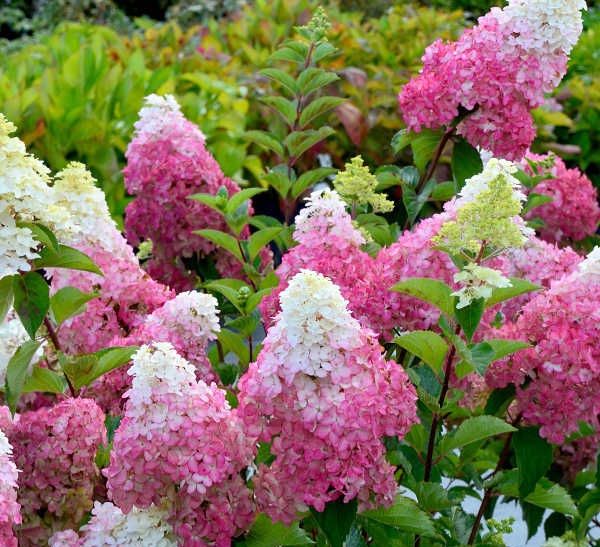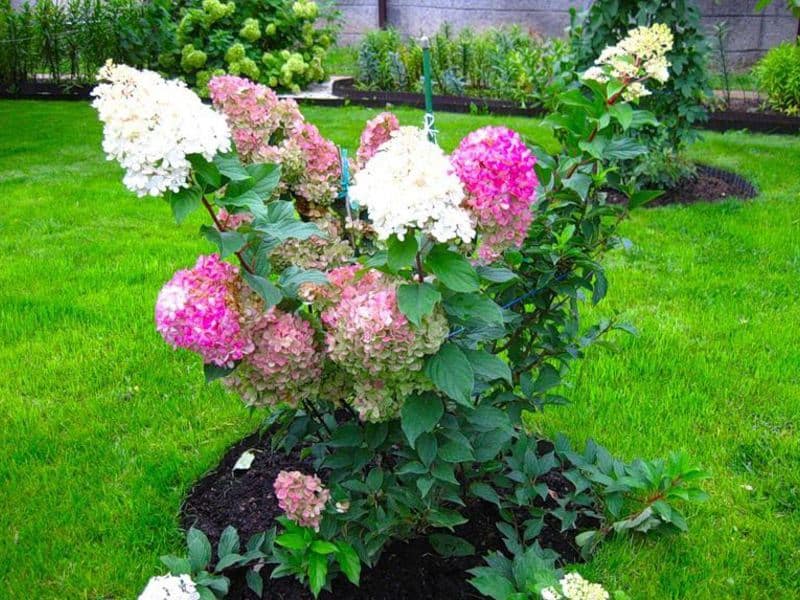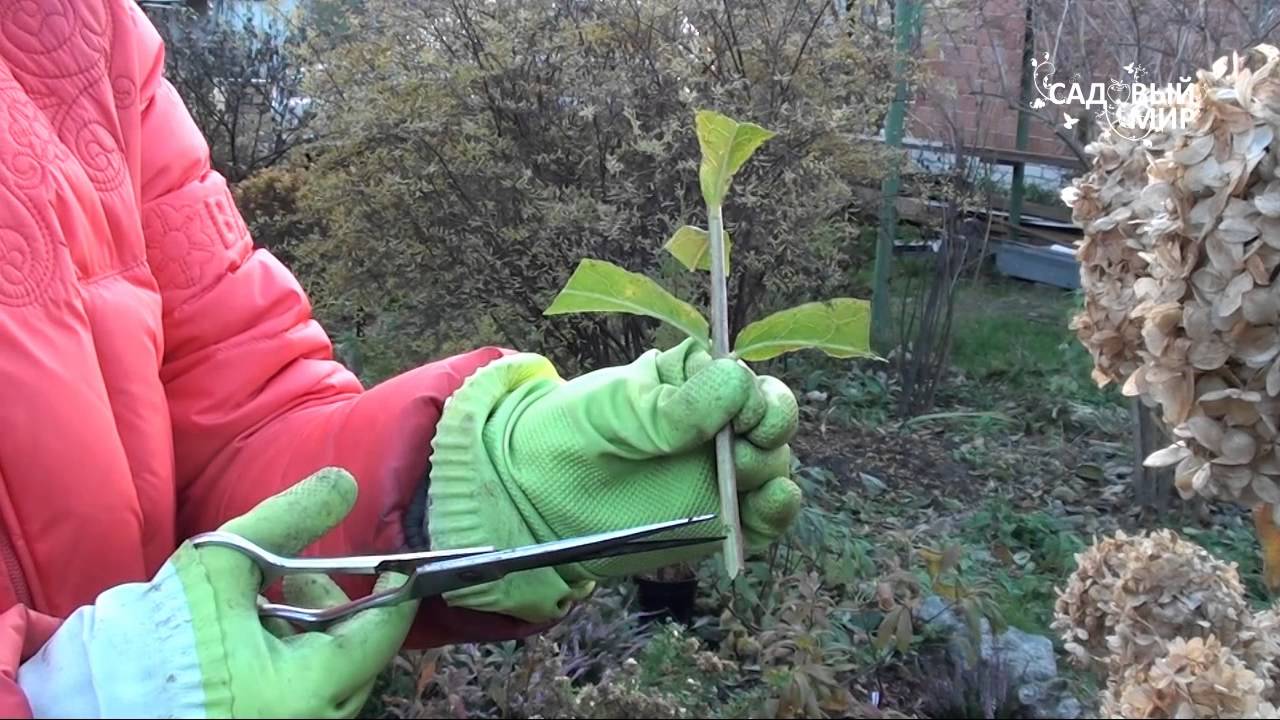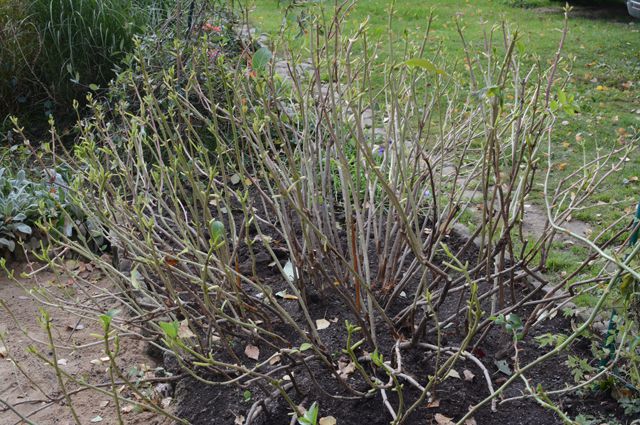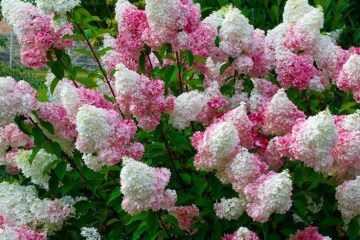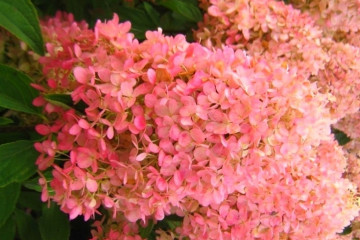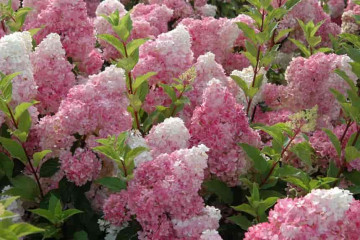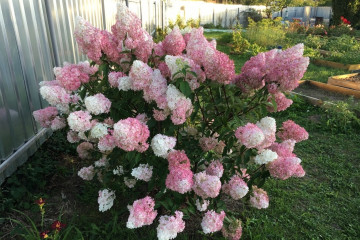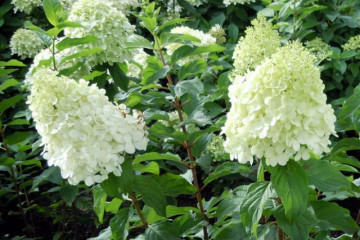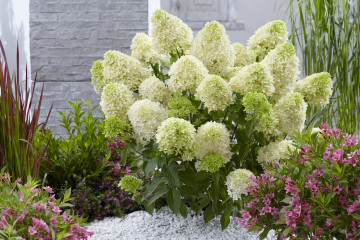Hydrangea Fraise Melba (Hydrangea Paniculata Fraise Melba) - description
Content:
Hydrangea Fries Melba is a popular culture in ornamental gardening, appreciated for its unusual appearance and unpretentious care. The plant perfectly adapts to various climatic conditions. Withstands frosts down to -30 ... 35 ° С. At temperatures below the established minimum, the bushes require additional protection with agrofibre.
The origin of the hydrangea Fries Melba
Hydrangea Fraise Melba is a novelty in the collection of the French selector Jean Reno, introduced in the 20th century. The appearance of the hybrid flower was preceded by a long (10 years) and painstaking work. The name of the variety is given in honor of the strawberry dessert with cream due to the pyramidal shape of the inflorescences of white at the top and red at the base.
Flower descriptions
Hydrangea Melba Freyzi is a paniculate ornamental shrub reaching a height of 2 m, it looks compact and does not require a garter. The branches of a young plant have a dark red tint, over time they take on a brown color. Round green foliage, pointed at the edges, is attached to the shoots with long petioles. Branching on straight-growing shoots is excluded.
Large openwork inflorescences (40-55 cm long), like a pyramid, change color during flowering: pink petals turn white, light ones acquire a brown color, the upper part remains white.
The peak of flowering of hydrangea Frez Melba falls in the middle of summer, lasts until frost, no fruits are formed. Inflorescences appear annually, immediately after planting. Additional care of the hybrid is not required. The plant lives for 30-40 years.
The disadvantages of the culture include the difficulty of obtaining seeds, susceptibility to fungal diseases. The variety does not perfectly cope with drought and rots when there is an excess of moisture.
Transplant hydrangea after purchase
The best period for planting hydrangeas outdoors is the end of April, May. In summer, the root system will grow and get stronger for wintering. By purchasing a seedling in a pot, you can also safely plant it in the summer. Hydrangeas take root well on acidic soil. The land should not contain lime and manure. Often gardeners add plant residues, humus, needles contained in high-moor peat.
Optimal location
The main parameter for choosing a place for planting hydrangea Freise Melba is the ability to receive sunlight for at least 6 hours / day. If placed in the shade, the flowering quality will deteriorate. The distance between individual bushes should be 1.2-1.5 m, this measure will allow the roots and crown to receive a sufficient level of nutrition and lighting.
The soil
Panicle hydrangea prefers slightly acidic soils (ph). Fertile loam is ideal for development. Sandstone will not be able to retain useful components, the growth of the plant will slow down. Wet lowland areas threaten to rot.
Step-by-step planting process
Planting hydrangea Vanilla Melba is carried out in the following sequence:
- Dig a hole with sides of 50 cm.
- Filled with broken brick or expanded clay drainage (10-15 cm).
- Pour a mixture of sod land mixed with peat and sand. For constant maintenance of soil moisture, it is advisable to add a hydrogel.
- When planting in spring, it is recommended to remove young shoots for 3-4 buds, without wasting the power of the plant on the development of shoots, initially the culture should grow roots.
- The roots of the seedling are well moistened in the purchased pot.
- The sprout is placed vertically in a wet hole, sprinkled with earth, leaving the root collar on the soil surface.
- The soil around the shoots is compacted and watered with two buckets of water.
Planting a sprout takes a minimum of time and is not difficult even for beginners.
Reproduction
Hydrangea is propagated by cuttings, dividing the bush, layering. When planting with seeds and grafting, caring for the hydrangea Fraz Melba paniculata is laborious and causes difficulties for amateur gardeners. The division of the bush is unproductive, the disadvantage of reproduction by layering is the limited number of branches for bending. The most effective and affordable method for breeding hydrangeas is cuttings.
Cuttings
The plant will take root well if you follow the basic recommendations for cuttings. Experienced gardeners cut the shoots from the bush in the early morning or cloudy weather. Green cuttings 10 cm long are cut from annual shoots, the upper leaves with several buds shortened by a third are left. The processes connected by a bundle at the bottom are treated with a growth stimulator, the upper incision is disinfected with green paint and planted at an angle in a container.
The substrate for the shrub is prepared on the basis of turf, peat and sand, in a ratio of 1: 3: 4. The stalk is placed in a dug groove 5 cm deep. The soil is preliminarily disinfected in an oven at a temperature of 200 degrees. A more convenient option would be to use a ready-made soil mixture for azaleas.
The sprouts are covered with glass jars, aired weekly for 15 minutes. Within a month, the cuttings take root, the shelter is removed. In zones with a mild climate, the shoots are planted in moist loamy soil, in winter the shoots are carefully closed. In the northern climatic zone, the rooted hydrangea is left in a cool room until next spring.
Growing from seeds
Planting of Freesia Melba hydrangea seeds is carried out in open areas and in seedling boxes. Before sowing, the seeds are soaked overnight in water, then scattered over the prepared soil, covered with a small layer of soil on top and irrigated with water. Seedlings are protected from frost with polyethylene.
Care
For the normal development and long-term flowering of hydrangeas, you should take care of regular watering, mulching the soil, fertilizing, pruning, warming for the winter.
Watering mode
The soil under the Frize Melba hydrangea bush must be constantly moist. The plant is watered with warm soft water, one bucket per day. During the dormant period, the soil is moistened weekly in dry weather, in summer - once every 3 days. It is desirable to use soft water for irrigation, with a pH of about 5.5.
Top dressing
The first feeding is carried out in the spring using humus, the next one - during the growing season (they switch to phosphorus-potassium fertilizers). Then the shrubs are fertilized 2 times a month, alternating mineral and organic substances.
Mulching
The first mulching is carried out immediately after planting a young sprout, using compost or humus. Then the mulch is renewed every 2 months.
Pruning
In order for the peduncles to be large, poorly developed shoots damaged by frost are removed in the spring. In the fall, weak shoots and inflorescences are cut off.
During flowering
Direct exposure to ultraviolet radiation negatively affects the flowering of the Frize Melba panicle hydrangea, if the sun is at its zenith, it is important to take care of creating partial shade. Also, the culture is threatened by drying out of the roots in the absence of frequent watering during a dry period. To the general list is added salvation from bacteria and microbes, top dressing, which provides the decorative properties of the culture. In the middle of summer, hydrangea is fertilized with potassium and phosphorus.
During the rest period
During the dormant period, the hydrangea Freyzi Melba needs to mulch the soil with a mixture of humus and dry leaves. A layer 20 cm high will retain moisture and protect the plant from freezing. Feeding the crop after flowering is not worth it. It is enough to provide moderate watering and weed removal.
Preparing for winter
Colds of Fries Melba are not terrible, the variety has high winter hardiness. In autumn, the leaves of the hydrangea are removed, leaving only the top, the area around the stem is sprinkled with dry soil. Shrubs are wrapped with agrofibre, mulched and fed with potassium salt with superphosphate, 50 grams per bush. Nitrogen is not needed in the fall.
Diseases and pests
In cool weather, Fraz Melba is at risk of powdery mildew. The spread of gray plaque on the branches and leaves indicates the need to treat the culture with a solution of "Fitosporin". The second problem is aphids that suck out juices. Insects infect the bush with infection and damage. Cope with pests means: "Fitoverm", "Aktellik", "Trichopol". The solution is prepared according to the instructions and sprayed. From folk methods, infusions of garlic, onion peels are effective.
With hydrangea Fries Melba, excellent landscape compositions are obtained, pleasing to the eye and emphasizing the delicate taste of the owner of the garden. Flowers look harmonious in the garden in combination with rhododendrons, phlox, highlander, cuff or stonecrop. Flower beds that include 3-4 bushes of paniculate culture look good. Planting hydrangeas along the birch trees, as recommended by landscape design experts, will cause many challenges. In order to avoid competition for moisture, it is better to practice such tandems in areas with a humid microclimate.
Video
